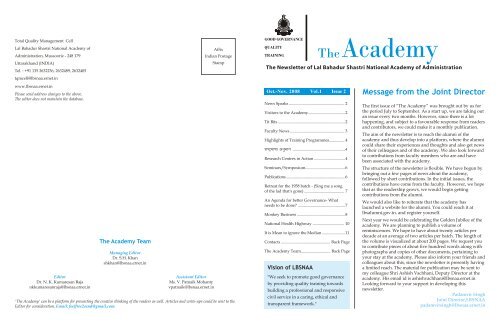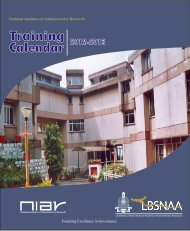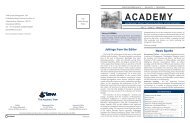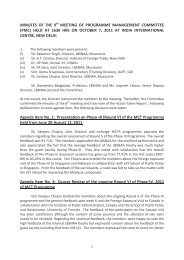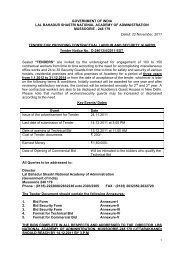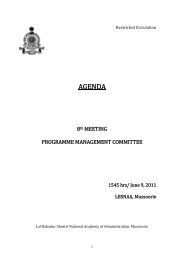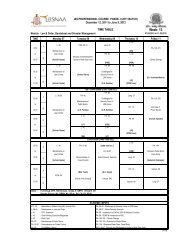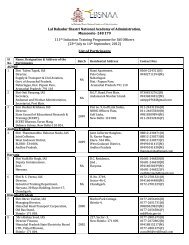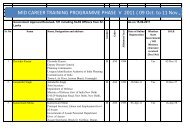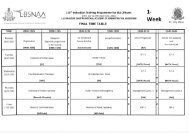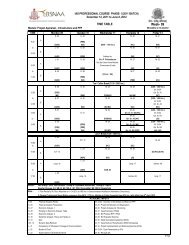Free Download - lbsnaa
Free Download - lbsnaa
Free Download - lbsnaa
Create successful ePaper yourself
Turn your PDF publications into a flip-book with our unique Google optimized e-Paper software.
Total Quality Management Cell<br />
Lal Bahadur Shastri National Academy of<br />
Administration, Mussoorie - 248 179<br />
Uttarakhand (INDIA)<br />
Tel. : +91 135 2632236, 2632489, 2632405<br />
tqmcell@<strong>lbsnaa</strong>.ernet.in<br />
Affix<br />
Indian Postage<br />
Stamp<br />
GOOD GOVERNANCE<br />
QUALITY<br />
TRAINING<br />
TheAcademy<br />
The Newsletter of Lal Bahadur Shastri National Academy of Administration<br />
www.<strong>lbsnaa</strong>.ernet.in<br />
Please send address changes to the above.<br />
The editor does not maintain the database.<br />
Editor<br />
Dr. N. K. Kumaresan Raja<br />
nkkumaresanraja@<strong>lbsnaa</strong>.ernet.in<br />
The Academy Team<br />
Managing Editor<br />
Dr. S.H. Khan<br />
shkhan@<strong>lbsnaa</strong>.ernet.in<br />
Assistant Editor<br />
Ms. V. Patnaik Mohanty<br />
vpatnaik@<strong>lbsnaa</strong>.ernet.in<br />
'The Academy' can be a platform for presenting the creative thinking of the readers as well. Articles and write-ups could be sent to the<br />
Editor for consideration. Email: feelfree2send@gmail.com.<br />
Oct.-Nov. 2008 Vol.1 Issue 2 Message from the Joint Director<br />
News Sparks ...................................................... 2<br />
Visitors to the Academy.................................... 2<br />
Tit Bits ................................................................. 2<br />
Faculty News ..................................................... 3<br />
Highlights of Training Programmes............... 4<br />
jk"VªHkk"kk vuqHkkx ................................................... 4<br />
Research Centres in Action ..............................4<br />
Seminars/Symposium.......................................6<br />
Publications ...............................................................6<br />
Retreat for the 1958 batch - (Sing me a song<br />
of the lad that's gone) ....................................... 7<br />
An Agenda for better Governance- What<br />
needs to be done? .............................................. 7<br />
Monkey Business ...............................................8<br />
National Health Highway ............................... 10<br />
It is Mean to ignore the Median ...................... 11<br />
Contacts ................................................ Back Page<br />
The Academy Team............................. Back Page<br />
Vision of LBSNAA<br />
"We seek to promote good governance<br />
by providing quality training towards<br />
building a professional and responsive<br />
civil service in a caring, ethical and<br />
transparent framework."<br />
The first issue of “The Academy” was brought out by us for<br />
the period July to September. As a start up, we are taking out<br />
an issue every two months. However, since there is a lot<br />
happening, and subject to a favourable response from readers<br />
and contributors, we could make it a monthly publication.<br />
The aim of the newsletter is to reach the alumni of the<br />
academy and thus develop into a platform, where the alumni<br />
could share their experiences and thoughts and also get news<br />
of their colleagues and of the academy. We also look forward<br />
to contributions from faculty members who are and have<br />
been associated with the academy.<br />
The structure of the newsletter is flexible. We have begun by<br />
bringing out a few pages of news about the academy,<br />
followed by short contributions. In the initial issues, the<br />
contributions have come from the faculty. However, we hope<br />
that as the readership grows, we would begin getting<br />
contributions from the alumni.<br />
We would also like to reiterate that the academy has<br />
launched a website for the alumni. You could reach it at<br />
lbsalumni.gov.in. and register yourself.<br />
Next year we would be celebrating the Golden Jubilee of the<br />
academy. We are planning to publish a volume of<br />
reminiscences. We hope to have about twenty articles per<br />
decade at an average of two articles per batch. The length of<br />
the volume is visualized at about 200 pages. We request you<br />
to contribute pieces of about five hundred words along with<br />
photographs and copies of other documents, pertaining to<br />
your stay at the academy. Please also inform your friends and<br />
colleagues about this, since the newsletter is presently having<br />
a limited reach. The material for publication may be sent to<br />
my colleague Shri Ashish Vachhani, Deputy Director at the<br />
academy. His email id is ashishvachhani@<strong>lbsnaa</strong>.ernet.in .<br />
Looking forward to your support in developing this<br />
newsletter.<br />
Padamvir Singh<br />
Joint Director,LBSNAA<br />
padamvirsingh@<strong>lbsnaa</strong>.ernet.in
2 The Academy Oct.-Nov. 2008<br />
3 The Academy Oct.-Nov. 2008<br />
News Sparks<br />
An alumnus gets often nostalgic when he/she<br />
think of the three main outside class room events<br />
during their foundation course. India Day, Fete<br />
and Trek are the three out door activities where<br />
group consciousness, cohesiveness and 'espirt de<br />
corpse' get demonstrably displayed. The Officer<br />
Trainees of 82nd Foundation Course celebrated<br />
'India Day' on 18th October, 'Fete' on the 25th<br />
October. The entire batch in various sub-teams<br />
accompanied by the faculty members were on<br />
trek from 27th September to 5th October, 2008.<br />
International Film Festival :<br />
Under of aegis of “Film Society, monopolized by<br />
a team of zealous Officer Trainees an<br />
International Film Festival was staged with<br />
spectacular creations of Doyens like Satyajit Ray,<br />
Akira Kurosewa, Florian Henckel von<br />
Donnersmarck, Vittorio De Sica and Frank<br />
Kapara on the 13th and 14th of November, 2008<br />
Down the Pipeline : The Academy is<br />
contemplating to subscribe JSTOR to further<br />
equip the state of art Library - Gandhi Smriti<br />
Library.<br />
A MoU between the Academy and Austin<br />
University Texas, USA is to get operationalised in<br />
due course on training and exchange of faculties.<br />
Visitors of Eminence<br />
The Academy had eminent visitors from Legislature,<br />
Executive and Judiciary- truly making the Academy<br />
as the point of convergence of all the three organs of<br />
Government towards augmenting real time inputs<br />
on Good Governance.<br />
Gubernatorial Authority<br />
His Excellency Shri B.L.Joshi , the Governor of<br />
Uttarakhand graced the valedictory ceremony of the<br />
105th Induction Training Programme designed for<br />
Officers from various state governments being<br />
promoted to IAS.<br />
Legislators<br />
Shri. Yashwant Sinha, MP (Rajya Sabha)<br />
Shri Sachin Pilot , M.P.<br />
Sri.Manvendra Singh, M.P.<br />
These Legislators were amidst us as “Resource<br />
Persons” in the flagship training programmes of the<br />
Academy.<br />
Hon'ble Justice ,Delhi High Court<br />
Hon'ble Justice Madan B Lokur, Delhi High Court<br />
graced the 13th module on “Ethical Issues on Today's<br />
Administration” by his august presence.<br />
Tit Bits<br />
Enthused amalgamation of cultures: India Day<br />
This is a red letter day for all Officer Trainees where<br />
they portray the various dimensions of the diverse<br />
culture of the 'Incredible India' with their indigenous<br />
music, dance, folklore and cuisine. This is the day of<br />
ordination of the Officer Trainees into India's<br />
Oneness. The Academy campus was lit up with multi<br />
cultural flavor that one of the Officer Trainees<br />
remarked “I wish I take birth in all the states if I have<br />
rebirths!"<br />
Trek - Reinventing adventurism<br />
This is the event when the expeditions and<br />
adventurism glimpsed by the Officer Trainees in<br />
Discovery and National Geography Channels while<br />
enjoying the comforts of snacks and coziness in their<br />
respective homes becomes a reality to them. To be<br />
frank Reality Bites! Imagine the young team of<br />
Officers willfully taking an inroad to the<br />
bewilderness of Garwal Himalayas in search of sheer<br />
adventure and spirit, thoroughly disconnected from<br />
the main land for days together! No kitchen, no<br />
western toilets, no electricity, no guest houses and no<br />
cell phones (the 207th Bone of most of us). Sky is their<br />
roof and all luxuriant flora and fauna with chirping<br />
himalayan birds become their kith and kins. After<br />
enduring the initial pains ,the reminiscence of the<br />
pseudo and suicidal living style, the trekkers begin to<br />
unite in the oneness of “Mother Nature” and into a<br />
sort of transcendental consciousness and return to the<br />
Academy, spiritually electrified and refurbished.<br />
Fun and Frolic of 'Fete'<br />
The Academy as its cause for social drive, anchoring<br />
upon the Officer Trainees of the Foundation Course<br />
stages 'Fete' every year.<br />
When the Officer Trainees become suddenly aware<br />
of the versatility and start a subtle praise mercilessly<br />
on the face of the Faculty members, you can<br />
understand that Fete is fast approaching and you are<br />
being transformed as a potential prey for their moral<br />
pressure which will cost you not less than One<br />
thousand Rupees in exchange of the 'Fete Day<br />
Coupons'. The coupons are the currency of the 'Fete<br />
Day' and the value of Rupee is just a plain piece of<br />
paper down the “Happy Valley where the Fete is<br />
held.<br />
As the day progresses, inflation gets to the sharp rise,<br />
with draining of 'Fete Coupons', as a direct impact of<br />
one's irresistible temptation to exchange with the<br />
tokens of the myriad stalls featuring games and<br />
mouth watering food stuffs. Catalyzed by the<br />
euphoria, one can consciously see the hijack of Indian<br />
Rupees from his/her purse in exchange to 'Fete<br />
Coupons', which testifies the efforts put by the<br />
Officer Trainees in attracting the visitors!<br />
The entire Mussoorie converges to the 'Fete' and the<br />
day progresses with increased fun and frolic. The<br />
sovereignty of faculty gets diminished to nil, as the<br />
Officer Trainees become the regulators of market<br />
forces in the Fete!<br />
Thus at the end of the day as the Officer Trainees<br />
convert fun and frolic of population of Mussoorie,<br />
into Indian Rupees, the huge sum so accrued was<br />
handed over for Social Cause!<br />
Academy Community acquiring Immunity!<br />
To protect the Academy family from communicable<br />
infections the Academy Dispensary vaccinated the<br />
officer trainees, faculty and employees against<br />
typhoid, hepatitis and influenza. The exercise is<br />
acquiring a permanent feature to contain the canvas<br />
of potential infections.<br />
Book Exhibition<br />
Gandhi Smriti Library organized a book exhibition<br />
from 21st to 23rd Sept, 2008 joined by twenty six<br />
publishers of national repute. The Academy family<br />
including the Officer Trainees, zealously pondered<br />
the array of books displayed and recommended<br />
some 1800 books for the library. This uniqueness of<br />
the Academy in its collection of books for the library<br />
has left every library racks with lip smacking tasty<br />
books for hungry minds!<br />
Robustness in Mind and Body<br />
Besides edifying the Officer Trainees to face the<br />
rigors of their challenging careers with a strong<br />
intellect, the academy takes adequate care for their<br />
physical fitness as well. This includes "Physical<br />
Training Sessions", every dawn whether it rains or<br />
snows. The 'Sports Complex' located in Happy<br />
Valley housing a 'state of art' multi gym, tennis<br />
courts, equestrian tracks and indoor games facilities<br />
help Officer Trainees to burn their calories and prune<br />
themselves.<br />
Faculty News<br />
Ms. Arti Ahuja, IAS(Orissa:1991) Deputy Director<br />
(Sr.) Joined the Academy on 13.4.2001. Her<br />
tenure completed and she got relieved on<br />
12.10.2008. Often termed as the 'Indian<br />
Bureaucracy's version of Jenny and Marx , she<br />
together with Shri. Manoj Ahuja IAS (Orissa:<br />
1991), the 'Harvard Economists', contributed the<br />
highest degree of professionalism and academic<br />
standards to the Academy during their tenures.<br />
Ms. Ranjana Chopra, IAS (Orissa: 1994) Deputy<br />
Director, has been elevated as Deputy Director<br />
( Sr.) with effect from 24.10.2008.<br />
Capacity Building of Faculty<br />
Shri. Ashish Vachhani, IAS (TN:1997.) Deputy<br />
Director underwent a training programme<br />
conducted by NICTU on “Video Edition” in the<br />
month of October, 2008<br />
Punch Line<br />
Hon'ble Shri Yashwant Sinha MP, Rajya Sabha<br />
had an enjoyable and lively interaction with the<br />
youthful Officer Trainees of 82nd Foundation<br />
Course. While responding to a tricky question<br />
whether Civil Servants can aspire to join politics,<br />
his reaction was sharp “Come to Politics and do<br />
Politics while in Politics but never do politics<br />
while you are in Administration”!
4 The Academy Oct.-Nov. 2008 5 The Academy Oct.-Nov. 2008<br />
Highlights of Training<br />
Programmes<br />
82nd Foundation Course, The Officer<br />
trainees were put to first hand real time<br />
exposure to rural India through “Village Visit<br />
Programme”, from 1st to 9th November,<br />
2008. They stayed in the heart of villages and<br />
socialized with the local populace of select<br />
villages in AP, Gujarat, MP, Orissa, Rajasthan<br />
and UP. These fresh trainees returned after<br />
the visit as potentially charged Samurais on<br />
their sensitization to rural realities.<br />
<br />
<br />
<br />
105th Induction Course for IAS Officers,<br />
Forty Officers from 10 states belonging to<br />
State Civil Services, promoted to IAS were<br />
housed in Indira Bhawan Campus and<br />
imparted professional training on Modern<br />
Management, Project Appraisal,<br />
Contemporary Issues in Indian Politics and<br />
Administration. They cherished the “Bharat<br />
Dharshan”, a sought after component of the<br />
training which enabled them to expand their<br />
horizons of their understandings of cultured<br />
dimension and varied governance of the<br />
incredible India.<br />
Retreat of 1958 Batch IAS Officers, Golden<br />
Jubilee Retreat for 1958 batch of IAS Officers<br />
numbering to twenty one, was organized for<br />
two days on 22nd and 23rd of September,<br />
2008.<br />
13th 'training programme' on “Ethical Issues<br />
in today's Administration”, The one week<br />
training module was held from 25th to 29th<br />
August 2008, with twenty four participants<br />
from IAS representing fourteen states. The<br />
course faced a paradigm shift in pedagogical<br />
inputs, with panel discussions, case studies<br />
,experience sharing presentations clubbed<br />
with interaction with media personnel and<br />
politicians on ethics, doing away with the<br />
ceremonial sermonizing!<br />
One mind blowing suggestion that arose at<br />
the end of course evaluation from the side of<br />
the participants is, that the spouses of officers<br />
must be permitted to attend the course for<br />
effective sensitization on ethics!<br />
jktHkk"kk vuqHkkx<br />
vdkneh esa fganh i[kokM+k] 2008 dk vk;kstu<br />
& fjiksVZ &<br />
yky cgknqj ’kkL=h jk"V“h; iz’kklu vdkneh] elwjh esa fnukd 01<br />
flracj ls 14 flracj] 2008 rd fganh i[kokM+s dk vk;kstu fd;k<br />
x;kA bl miy{; esa] vdkneh LVkQ ,oa vdkneh ls lac)<br />
bdkb;ksa ds LVkQ ds fy, fganhrj Hkkf"k;ksa gsrq fganh Hkk"kk dh<br />
tkudkjh] dk;kZy; ls lacaf/kr lkekU; tkudkjh …lewg ^?k*‰]<br />
jktHkk"kk uhfr ls lacaf/kr lkekU; Kku] fganh Jqrys[k] fganh fuca/k<br />
ys[ku rFkk fganh dkO; jpuk izfr;ksfxrk,a vk;ksftr dh xbZaA<br />
fganh i[kokM+s ds nkSjku vk;ksftr fofHkUu izfr;ksfxrkvksa ds fotsrk<br />
izfrHkkfx;ksa dks fnukad 16 flracj] 2008 dks vk;ksftr iqjLdkj<br />
forj.k lekjksg esa iqjLd‘r fd;k x;kA bl lekjksg ds eq[;<br />
vfrfFk vdkneh ds la;qDr funs’kd] Jh in~eohj flag Fks rFkk<br />
dk;Z e dh v/;{krk jktHkk"kk izHkkjh] Jh nq";ar ufj;kyk]<br />
mifuns’kd ofj"B us dhA<br />
bl lekjksg esa] fofHkUu izfr;ksfxrkvksa ds fotsrk izfrHkkfx;ksa ds<br />
lkFk gh] okf"kZd fVIi.k rFkk elkSnk ys[ku izksRlkgu ;kstuk&<br />
2007&08 ds izfrHkkfx;ksa dks Hkh iqjLd‘r fd;k x;kA bl rjg] bl<br />
lekjksg esa dqy 31 izfrHkkfx;ksa dks] la;qDr funs’kd egksn; us<br />
iz’kfLr i= rFkk 11]300@&#i, ds udn iqjLdkj iznku fd,A<br />
dk;Z e dk lapkyu jktHkk"kk vuqHkkx ds lgk;d funs’kd …jk-Hkk-‰<br />
Jh uanu flag nqXrky rFkk lg;ksx Jh vkseizdk’k f}osnh] d-<br />
vuqoknd us fd;kA<br />
la;qDr funs’kd egksn; us vius lacks/ku esa vdkneh esa fganh ds<br />
iz;ksx ij larks"k O;Dr fd;k rFkk vdkneh esa dk;Zjr LVkQ dh<br />
fganh Hkk"kk dh l‘tu’khyrk dks c
6 The Academy Oct.-Nov. 2008 7 The Academy Oct.-Nov. 2008<br />
of Women and Child, Orissa, to assess the state<br />
government's “Mahila Shishu Desk” initiative. The<br />
main aim of the study is to highlight the lessons<br />
learnt from the ongoing activities and design a<br />
roadmap for continuous improvement to<br />
institutionalize the best practices.<br />
<br />
<br />
<br />
Seminars/ Symposium<br />
A National Level Conference on<br />
'Mainstreaming Gender Issues' was organized<br />
by the National Centre for Gender Training<br />
and Research on 13th to 15th November, 2008<br />
The National Institute of Administrative<br />
Research ( NIAR) at the benediction and<br />
benefaction of the 'Thirteenth Finance<br />
Commission' organized a National Level<br />
Workshop on “Development of Indicators of<br />
Governance” at Indian International Centre,<br />
New Delhi on 14th November, 2008.<br />
VIII Central Training Institute's Conference,<br />
The VIII conference hosted in Academy on<br />
16th October,2008 was in continuum to the<br />
previous conferences held in succession at<br />
various Central Training Institutes.<br />
Networking and sharing training resources<br />
amongst the Central Training Institutes was<br />
the pivotal theme of the conference. The<br />
deliberations triggered by collective wisdom<br />
resulted in quite a few novel<br />
recommendations, to name a few, the<br />
volunteership offered by Foreign Service<br />
Institute New Delhi to facilitate international<br />
training programmes for officers of varied civil<br />
services, creation of a Consortium of CTIs ,<br />
holding a thematic training module at the<br />
Academy for the different batches of yester<br />
years foundation courses that comprise of the<br />
conglomeration of officers from all the civil<br />
services.<br />
Faculty Publications<br />
An article on “NICTU An ICT Training Hub for<br />
Civil Servants” was published in Informatics An e-<br />
governance bulletin from NIC, Volume 17, No. 1,<br />
July 2008 jointly authored by NICTU Team.<br />
A Research Paper entitled “Women in Rural Indian<br />
Households and Energy Needs: Struggle and Solace<br />
Cultural Perspective to Reality” authored by<br />
Dr. N. K. Kumaresan Raja , Professor, Centre for<br />
Rural Studies was published in the Edited Volume<br />
on “The Culture of Energy” by Mogens Rudiger,<br />
Cambridge Scholars Publishing, UK, 2008<br />
Publications from the 'Cannons of<br />
Research' of the Academy<br />
The Academy proudly brings out two 'Journals',<br />
with and of profound professional acumen in the<br />
endeavor of translating the motto of the Academy<br />
by way of publications.<br />
The Administrator<br />
The Journal operates as a mirror of issues<br />
pertaining to contemporary issues in Indian as<br />
well as Global Public Administration. We are<br />
proud to hear from our officer trainees that the<br />
journal was a part of their life jackets during their<br />
gauntlet years of swimming in the waters of Civil<br />
Services Exams finding the shores!<br />
Service Quality<br />
“Service Quality”- the mitochondrion of the<br />
principles of “Total Quality Management”, a<br />
prodigy from the neurons of Shri. Padamvir Singh,<br />
the Joint Director, deciphers his aims of redefining<br />
the pre-established definitions of “Service Quality”<br />
of delivery systems in Government<br />
Administration.<br />
Utmost importance is given for 'out of box<br />
thinking' to ensure optimum quality, confirming<br />
to international benchmarks in every public<br />
service delivery system and articles spearheading<br />
such visions and missions of discovering the<br />
indicators ensuring “Service Quality” is the focal<br />
theme of the contents of the Journal.<br />
Retreat for the 1958 batch<br />
Arti Ahuja*<br />
The batch of 1958 was unique- it was the last batch of<br />
the IAS to be trained at the Metcalfe house in Delhi.<br />
After that, the training was shifted to the National<br />
Academy, as it was then called, at Mussoorie. From<br />
Metcalfe and its proximity to the powers at Delhi, to<br />
the cool, meditative environs of Mussoorie was<br />
indeed a quantum jump, literally and figuratively, for<br />
the idea of training civil servants. This was evident in<br />
the reminiscences of the batch- they recounted with<br />
delight their close interaction with the Prime Minister<br />
Mr Jawaharlal Nehru and other dignitaries including<br />
the Home Minister Mr Pant, before whom they<br />
successfully protested against shifting the Academy<br />
to Mussoorie during their training period! Metcalfe<br />
house, with its colonial grandeur and sprawling<br />
lawns symbolized the handing over of the reigns of<br />
government from the ICS to the IAS and the IFS. The<br />
batch was understandably nostalgic about the time<br />
spent there, and we were regaled with numerous<br />
stories about the training there.<br />
21 members of the batch, some with their spouses,<br />
attended the retreat. Members of the batch, who were<br />
no more, were fondly remembered by the entire<br />
batch before the proceedings started. For the first<br />
time, members of the Indian Foreign Service who<br />
were trained together with the batch at Metcalfe<br />
house were invited. One officer attended the retreat,<br />
and his reminiscences added depth to the<br />
deliberations. It was a pleasure for the faculty to be<br />
part of the sharing of their memories-the group had<br />
many highly distinguished members, who had<br />
achieved excellence in their careers as well as beyond<br />
that. They had braved many odds and achieved a lot<br />
for the country in the areas they had worked in. The<br />
batch also has been highly prolific-we were initially<br />
able to find 16 books written by the batch members,<br />
with more coming to light during the deliberations!<br />
During the retreat, the 82nd Foundation Course was<br />
also going on. Escort Officers from the FC were able<br />
to have a close and meaningful interaction with the<br />
seniors. There was also a structured panel<br />
discussion with all the young Officer Trainees of the<br />
Foundation Course- an experience that was found<br />
very useful by both groups. The 1958 batch also<br />
contributed to the training inputs by giving their<br />
suggestions on various areas of concern for the<br />
officer trainees. This was done through discussion<br />
in groups and arriving at a set of recommendations.<br />
The retreat was given a touch of warmth and colour<br />
by the spouses who gamefully sang at the Director's<br />
dinner and braved the sporadic rain showers at the<br />
valedictory in Polo ground. The last group photo<br />
with the ubiquitous umbrellas become probably the<br />
defining moment of the retreat and the batch gettogether.<br />
There were moments of rain and sunshine,<br />
but they were all greeted with good humour and<br />
immense camaraderie and grace. This was how the<br />
officers had also lived their lives- standing tall<br />
under adversity and paving the way for the future<br />
generation of officers. It was a pleasure coordinating<br />
the retreat for this unique and wonderful batch.<br />
* Former Deputy Director(Sr.), LBSNAA<br />
An agenda for better governance-<br />
What needs to be done?<br />
Padamvir Singh*<br />
To attain global standards in the quality of<br />
governance, consider adopting the following policy<br />
framework:<br />
Improve Service Delivery by focusing on the<br />
following key performance enablers:<br />
Prerequisites<br />
Develop and implement a core governance and<br />
core reform agenda;<br />
Firmly establish the rule of law and maintain<br />
public order at all times as the basic foundation of<br />
good governance;<br />
Keep public interest supreme and place people at<br />
the centre of all government activity;<br />
cont. on p.8
8 The Academy Oct.-Nov. 2008 9 The Academy Oct.-Nov. 2008<br />
Ensure zero tolerance towards corruption;<br />
Reorganization<br />
Redesign and rebuild a right-sized, citizen-centric<br />
and responsive structure of government;<br />
Review all old and outdated laws and update them<br />
and use them as instruments of accountability and<br />
development;<br />
Standards<br />
Provide quality services to the people in<br />
accordance with specified standards or charters,<br />
making use of state of the art technology and<br />
process re-engineering;<br />
Make public service delivery mechanisms<br />
transparent with effective implementation of the<br />
right to information;<br />
Use citizen and client feedback for continuous<br />
improvement;<br />
Ensure service standards through effectively<br />
implementing laws relating to consumer<br />
protection;<br />
Management Systems<br />
Ensure cost effectiveness and quality service by<br />
exploring alternative mechanisms for service<br />
delivery such as outsourcing and public-privatepeople<br />
partnerships;<br />
Adopt participatory mechanisms and teamwork in<br />
the planning, delivery and evaluation of public<br />
service delivery.<br />
Introduce performance management systems by<br />
developing measurable performance indicators<br />
supported by appropriate incentives and<br />
disincentives. Link budgets to outcomes and<br />
placements on considerations of performance and<br />
suitability;<br />
Ensure fiscal responsibility and sanctity of the<br />
budgetary process and institute effective planning<br />
and budget management systems;<br />
Human Resources<br />
Develop leadership at all levels through effective<br />
delegation so as to energize and drive<br />
improvement. Strengthen district level<br />
administration for effective delivery of services<br />
provided by the state government;<br />
Encourage innovation and creativity;<br />
Evolve and implement human resource<br />
development initiatives to manage change in the<br />
context of paradigm shifts in public administration<br />
and technology;<br />
Ensure security of tenure and provide for<br />
transparency in promotions, transfers and<br />
placements;<br />
Decentralize<br />
Strengthen rural and urban local bodies for<br />
effective service delivery by devolution of<br />
functions, finances and functionaries and through<br />
capacity building programmes;<br />
Evaluate and Benchmark<br />
Undertake third party appraisal and<br />
benchmarking of programmes, schemes and<br />
institutions.<br />
Monkey Business<br />
B. Ashok*<br />
* Joint Director,LBSNAA<br />
Our verdant Mussoorie campus is cohabited (along<br />
with officers: trainers and trainees) by around four<br />
hundred rhesus monkeys. They are everywhere,<br />
looking for food from mess leftovers, fruit trees and<br />
even residential litter boxes. Most are Rhesus varietythe<br />
ugly yellow grey ones, and Langurs- the black<br />
faced taller ones. They are protected by the wild life<br />
Act and Rhesus monkeys are also revered as<br />
descendents of Hanuman by the local populace.<br />
These works in their favor and all attempts by the<br />
Academy to relocate them or control their occasional<br />
misbehavior have been wasted.<br />
The three hundred odd Rhesus monkeys are also<br />
divided into three or four warring clans, each led by<br />
a vicious looking huge chieftain. My first encounter<br />
with a large mature adult sparring chieftain was<br />
awesome enough. We had moved into our residence<br />
behind Kalindi and I was rushing down the<br />
stairs for a meeting. Hey presto, as in<br />
Kalyanasougandhikam there he sits on the head of<br />
stairs, ignoring my shooing or pleadings to give way.<br />
Option less I lifted a medium broken brick and<br />
aimed. He snarled and glared his canines and turned<br />
around in full ambush posture. His war cry<br />
is still ringing in my ears, and responding answer<br />
calls were poring out from atop the water tank. I<br />
barely escaped into my house with my shirt on.<br />
Since then I keep an air rifle which seems to have an<br />
impact on the clan and use it very often to clear way.<br />
Generally monkey chiefs spare adults unless you get<br />
caught in the cross fire: that is when the clans are<br />
fighting ferociously! If the chieftain is<br />
securing his exclusive access to the choice female<br />
under challenge, well even if you are adult they may<br />
spring on you, mistaking you to be an extra<br />
challenger. Observing them brings to my mind the<br />
theory of my esteemed trainee from Haryana which<br />
explains the ills in our system. It can be called the<br />
theory of the "Jhavad bandhar"! I had the good<br />
fortune to travel with this gentleman to USA and<br />
back on training. Naturally officers discuss the ills of<br />
politicians, the system etc. For every ill identified,<br />
our gentleman would retort, with a loud drool draw<br />
on his glass of scotch:<br />
"Sirjee, sub Jhavad bandhar ki kahani hai!"(All this is<br />
the story of the chieftain monkey). He would explain<br />
the dominating strategies of the Jhavad vis a vis the<br />
females, and conclude: "Sub unke hain, our baki sub<br />
sirf thali bachthe rahte hain" (The winner takes all,<br />
the rest can just remain clapping).<br />
After an extended stay in Europe and witnessing the<br />
historic Ivrea carnival near Milan, I can understand<br />
what he says. Ivrea is a small town where the custom<br />
of Prima Nocta (the first post marriage night of every<br />
virgin belonged to the local feudal lord) was<br />
challenged by one Violetta who resisted him and<br />
beheaded the Lord in the nocturnal encounter. To<br />
celebrate this freedom, Ivreans dress up as the agents<br />
of the feudal lord, roam around in horse carts and<br />
pelt each other with oranges on the appointed winter<br />
day. Around Seven million oranges are pelted. The<br />
subtext is you like a woman on the street you can<br />
pelt her on the day without attracting the police. By<br />
custom she has to consider you. The Mayor of the<br />
town issues a permission allowing the pelting of<br />
oranges exempt from nuisance /petty offence list. Of<br />
more interest is the choice brew sold from the paved<br />
roadside kiosks through out the day. One gulp and<br />
the winter turns warm enough! One must also<br />
mention the beautiful women of the town<br />
celebrating their love out in the open, displaying<br />
intimacy and freedom. Well, the Harayanvi theory of<br />
Jhavad bandar has been overturned in some parts of<br />
the World, nevertheless it did exist. Of the more<br />
mundane pranks of these animals have been flicking<br />
innocuous things with serious consequences. As it<br />
happened to us, one of my trousers turned up in the<br />
washed pile of our esteemed neighbors, the Chopras.<br />
In fact Mr Chopra found it out when he tried to wear<br />
it and discovered he had enough space for two!<br />
Fortunately we are both very understanding<br />
husbands and wives, and promptly blamed the<br />
monkeys for the trouser switch. But for the monkeys,<br />
I cannot imagine an answer to Preeti how my<br />
trousers can't keep themselves to our wardrobe!<br />
Besides when we were trainees I remember the few<br />
lady trainees complaining regular loss of costly<br />
underwear left to dry. Those days we did not have<br />
launderettes. In retrospect, it is not impossible to<br />
imagine a queer monkey trying out the possibly<br />
super padded ones in the wild and dancing away his<br />
way into bliss. The gentlemen of the services cannot<br />
be stealing women's underwear, though I have met<br />
quite a few real queers fond of flicking many strange<br />
things!<br />
It is not funny all the time. A couple of children of<br />
faculty members were bitten and had to undergo<br />
vaccination etc. There was pressure on me as the<br />
then in charge of estates to control the menace. We<br />
did explore options. We located a firm of monkey<br />
controllers /catchers who offered their<br />
services. One hitch stopped the operation. The terms<br />
of the firm said they will charge a few thousands per<br />
day of operation, irrespective of the numbers of<br />
monkeys caught and transported away into jungles.<br />
Finance advisor wouldn't accept it. This way the firm<br />
has to be paid even if no monkey is ever caught. He<br />
wanted a per monkey fool proof quote while the<br />
firm wouldn't have any of it. The 'Jhavad bandar's<br />
had their lucky day and were free to go amok again.<br />
Presently my friend Rajesh Aryaji has an innovative<br />
Hi tech plan to install some ultrasound scare for the
10 The Academy Oct.-Nov. 2008 11 The Academy Oct.-Nov. 2008<br />
monkeys near the faculty and OT residences. The<br />
health prospects for humans of these technologies is<br />
under study since what is scary for monkeys cannot<br />
be totally beneficial for humans, them being 99.5%<br />
genetically related to us. (Aryaji corrects me that<br />
some prankster probationers are 150% related). Some<br />
faculties feel that trainees are challenging enough<br />
without any prospective ultra sound induced<br />
mutations!<br />
Seriously, the Academy is a place where we have to<br />
throw "the monkey on our back" away and come out<br />
of our comfort zones. Weightlessness to fly high is<br />
the aim, freedom in thinking and action come<br />
through freeing the binds and comfort zones of the<br />
mind. Monkeys, Jhavad and ordinary add to the<br />
challenge and remind us the fluidity of the World we<br />
inhabit. Let them be, let us be, and let us keep<br />
learning from each other.<br />
* Deputy Director, LBSNAA<br />
National Health Information Highway<br />
Dr. S. H. Khan *<br />
Researchers have joined IBM's Business Consulting<br />
Services on a pilot program with one significant<br />
healthcare group. The challenges faced by the team<br />
were formulating healthcare standards specific to<br />
India and convincing healthcare entities across the<br />
nation to integrate those standards into their business<br />
processes. The partnership formed with a large<br />
hospital chain in India will facilitate the formation of<br />
a working committee, consisting of hospitals and the<br />
IT and Health ministries, to create health data<br />
standards for the country. IBM has already deployed<br />
Clinical Document Architecture (CDA) over the data<br />
grid to demonstrate standards-driven claim data<br />
exchange. And, as the first pilot program is<br />
progressing, other programs will be rolled out to two<br />
hospitals and two insurance third-party<br />
administrators.<br />
National Health Information Highway system offers<br />
information technology to help reduce medical<br />
errors, improve efficiency, assist planning (locations<br />
of specialty hospitals or medical schools, crisis<br />
management, drug and equipment supply and<br />
budgeting etc.), and accelerate research and training<br />
(using diagnosis data to train medicos or using<br />
medical problems captured on the network to build<br />
test cases.) In 2002, India's healthcare industry<br />
contributed five percent to the Gross Domestic<br />
Product (GDP) and employed approximately four<br />
million people. By 2012, it is projected to contribute<br />
8.5 percent of the GDP. Healthcare spending in the<br />
country will double over the next 10 years with<br />
private healthcare contributing a large portion of this<br />
spending, rising from US $14.8 billion to US $33.6<br />
billion. Because the traditional system of medicine is<br />
faced with escalating healthcare costs, the state<br />
health systems desperately need to improve<br />
efficiency in how they allocate and use health<br />
resources to combat the many problems the rapidly<br />
developing country has. These problems include<br />
infant and maternal mortality rates that are still high;<br />
basic reproductive and child health services, supplies<br />
and infrastructure needs that are unmet; and<br />
universal immunization of children against all<br />
vaccine-preventable diseases has not yet been<br />
achieved. In addition, the government is striving to<br />
achieve zero-level growth of HIV/AIDS, reduce<br />
mortality from vector-and water-borne diseases by<br />
50 percent, and increase the use of public health<br />
facilities-all by 2015.<br />
Other healthcare highway capabilities include:<br />
facilitating electronic data exchange (which will<br />
automate the current manual process and reduce<br />
the time it takes to settle claims from the current<br />
four to six weeks),<br />
providing data standardization (which will allow<br />
for interoperative and collaborative networks),<br />
middleware-based (to allow flexible collaboration<br />
among multiple third-party administrators and<br />
hospitals nationwide),<br />
supporting information integration and extraction<br />
(to answer queries from the doctors and<br />
administrators),<br />
supporting hybrid client platforms and<br />
programming languages (to allow different TPAs<br />
and hospitals to be part of the network),<br />
using industry standard interfaces (so that crosstraining<br />
and re-training won't be necessary),<br />
offering security through an authorized data<br />
channel (so that only authorized personnel can<br />
access this highly confidential information), and<br />
provide auditing, which is required by the IRDA,<br />
the insurance regulatory body in India.<br />
High-tech, five-star hospitals have pushed costs skyhigh.<br />
A simple headache will warrant a CT scan to<br />
rule out a brain tumour. Doctors have used the CPA<br />
to further justify expensive and sometime<br />
unnecessary investigations and therapies. On the<br />
other hand, sophisticated equipment is available in<br />
government hospitals, but it is often not in working<br />
condition. According to the VHAI report, the<br />
government's annual public health expenditure is<br />
about Rs. 10,000 crore - a pittance compared to an<br />
estimated expenditure in the private sector of<br />
between Rs. 40,000 and Rs. 60,000 crore. Private<br />
services experience support from ruling class , who<br />
often receive free treatment-which is actually<br />
intended for the poor, and is a pre-condition for the<br />
various concessions and tax benefits that these<br />
hospitals enjoy. The entry of the corporate hospital<br />
signals an open focus on profit rather than people's<br />
needs. Private medical colleges and high-tech private<br />
hospitals are proliferating across the nation. In<br />
essence ,stakeholders in these ventures, treat medical<br />
education and healthcare as any other industry<br />
which survives on profit.<br />
* Deputy Director, LBSNAA<br />
It is Mean to ignore the Median<br />
Alok Kumar *<br />
India is an economy in transition; I would say that it<br />
is at an inflection point. The right policy mix could<br />
put it well on its way to becoming a developed<br />
country. It is the second fastest growing economy in<br />
the world, clocking up average growth rates of 8-<br />
8.5% per annum in the last 5 years. It has seen a<br />
steady increase in consumption as measured by the<br />
Real Average Monthly Per Capita Expenditure<br />
(MPCE). The Below Poverty Line [income levels less<br />
than $1 (PPP) per day] population has been<br />
decreasing at a rate of 1% per annum.<br />
That said, however, it is also clear that the number of<br />
poor at 267 million [2005] remains unacceptably<br />
large. If you also include the fact that of the<br />
remaining population, 190 million earn between $1<br />
and $1.25 a day and a further 170 million earn<br />
between $1.25 and $1.35 a day, it would be clear that<br />
a large number of people 55% to be precise-are<br />
unable to afford a dignified life. The increases in per<br />
capita income (currently $575) largely reflect the<br />
income growths of the top quintile of the population.<br />
In fact, the data on changes in per capita<br />
expenditures reveal that the increase (between 1993<br />
& 2004) in case of top quintile (richest 20% of the<br />
population) was 2.03% per annum against 0.85% for<br />
bottom quintile.<br />
It could arguably be said that a few billionaires could<br />
possibly raise the mean income; without affecting the<br />
vast majority of poor. Very recently we have seen<br />
how the voters rejected the idea of “India Shining”<br />
which focused on a very narrow base of well to do<br />
sections. What are the lessons for the policy makers?<br />
The inherent learning from the above is that public<br />
policy to be effective needs to target the median<br />
voter. From our high school mathematics, we would<br />
remember that the median voter would be that voter<br />
who would divide the population exactly into two<br />
halves (one half having income greater and the other<br />
having an income lower than the median voter). If<br />
the median voter does not gain from the policy, it<br />
may not be achieving its objective.<br />
New schemes such as NREGS, RKVY & NRHMtarget<br />
exactly the median voter but the jury is still<br />
out whether they shall be able to achieve the<br />
intended outcomes in view of the delivery systems in<br />
place. Perhaps the expenditure data published by the<br />
next “thick” round of National Sample Survey on<br />
expenditures and poverty would throw some light<br />
on the subject.<br />
Till then, however, it would be safe to say with due<br />
apologies to John Allen Paulos- that it is “Mean to<br />
Ignore the Median”<br />
* Deputy Director ( Sr.), LBSNAA


